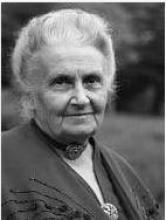
Dr. Maria Montessori was one of the most influential pioneers in education for children in the 20th century, and her methods have continued to be utilized in Montessori schools around the world. Her discoveries in working with children led to teaching methods that allow for child-directed learning with the teacher facilitating the environment to aid in the child’s interests with the message to “follow the child.”1
Maria Montessori was born in Italy in 1870 and holds the distinction of becoming Italy’s first female doctor in 1896 before moving into the field of early childhood education. From her work at the University of Rome’s psychiatric clinic, Dr. Montessori became interested in the treatment of children with special needs and worked and wrote on their behalf. She became the director of a school for children with learning disabilities in 1898, and after working with them for two years, these children, who were formerly considered uneducable, took and passed successfully a school examination along with regular students. She was viewed as a miracle worker by other educators at the time, and this prompted her to study anthropology and psychology to unravel the potential of “normal” children.2
In 1907, Dr. Montessori was given the charge of fifty poor children from the San Lorenzo slum on the outskirts of Rome. Her unprecedented success with these children was publicized around the world, and she was invited to visit the United States by Alexander Graham Bell, Thomas Edison, and others. She spoke at Carnegie Hall in New York City and then set up a classroom behind a glass wall for four months in 1915 at the Panama-Pacific International Exposition in San Francisco, California, where spectators watched twenty-one children being taught using her methods. The only two medals awarded for education at the Exposition were both given to the Montessori class.3
Dr. Montessori was forced into exile during World War II and lived and worked in India, where she developed her work, Education for Peace. She was twice nominated for the Nobel Peace Prize. Returning to Rome after the war, she further developed her methods for working with school-aged children, but came to realize that the methods could also be adapted for use with infants, which became a three-year full time program for infants to three year olds.4
Dr. Montessori’s methods evolved from her observations that children concentrated most effectively when they were interested in the activity and that they are intrinsically motivated to learn. She realized that children prefer order in their lives and strive to maintain it. When presented in an enjoyable way, they prefer real, purposeful work over playing with conventional toys. And children like to take care of themselves, and do not need to be rewarded for their work when they are allowed to choose their own activities. Thus her educational methods were based on the idea of freedom for the child within a carefully planned and structured learning environment.5
Dr. Montessori believed that a child would always choose a purposeful, interesting activity that met his needs in the real world over one based on fantasy. She felt that children would instinctively rather choose to acquire knowledge than to engage in senseless play. Thus, when given the opportunity to choose the activity, what can be seen as play to some because of the freedom involved, is actually considered work for the child to Montessori. And this definition of work is fundamentally different for the child than for adults: the child enjoys the process more than the end result, needs to repeat the activities over and over to fulfill an inner need, and is excited and energized through work rather than fatigued and burdened by it.6
Montessori schools group the children in three or six-year spans and have the same teacher for the group. This multi-aged grouping allows for children of different abilities to learn from each other. Classes for children aged 3 to 6 and 6 to 12 can have large groups of 30 to 35 children with one trained teacher. Learning is self-directed with seldom two or more children studying the same thing at the same time. Children learn individually with the aid of the teacher supporting their interests and guiding their research and exploration. The classroom is a prepared environment with materials available to aid the children’s discovery. The class schedule allows for at least one 3-hour uninterrupted work time each day for individual interests, then group lessons are taught. Students contract with teachers to balance their work, but no grades are given. However, the results of self-directed learning in conjunction with the guided lessons taught by the teacher result in children that are well-educated and ready for college entrance exams.7
Maria Montessori and Rudolf Steiner, founder of the Waldorf Schools, were contemporaries and shared many of the same views even though their teaching methods were quite different. They both emphasized the education of the whole child mentally, physically, psychologically, and spiritually over the traditional classroom curriculum, stressed the importance of the natural environment, and valued a rich variety of art, music, dance, and theater for all ages.8
- 1. “An Inroduction to Montessori Philosophy & Practice.” The Michael Olaf Montessori Company. < http://www.michaelolaf.net/1CW312MI.html > 4 Aug. 2011.
- 2. Ibid.
- 3. “Maria Montessori, MD.” The International Montessori Index. < http://www.montessori.edu/maria.html > 4 Aug. 2011.
- 4. Ibid.
- 5. “Maria Montessori.” Montessori House. < http://www.montessorihouse.net/index.php?option=com_content&view=article&id=47&Itemid=63 > 4 Aug. 2011.
- 6. “Play.” Montessori Education. < http://www.montessori.org.uk/magazine-and-jobs/library_and_study_resources/teacher-training-study-resources/topics/play > 4 Aug. 2011.
- 7. Op. cit., An Introduction to Montessori Philosophy & Practice.”
- 8. Stephenson, Susan Mayclin. “Montessori and Waldorf Schools.” The Michael Olaf Montessori Company. < http://www.michaelolaf.net/MONTESSORI%20and%20WALDORF.html > 4 Aug. 2011.

